Algebra vs. Trigonometry — What's the Difference?
By Fiza Rafique & Maham Liaqat — Updated on March 21, 2024
Algebra focuses on manipulating symbols and equations to solve problems, while trigonometry deals with the relationships between triangle angles and sides.

Difference Between Algebra and Trigonometry
Table of Contents
ADVERTISEMENT
Key Differences
Algebra is a branch of mathematics that deals with symbols and the rules for manipulating these symbols to model and solve problems. It includes operations on equations involving variables and constants to find unknowns. Trigonometry, on the other hand, is focused on the study of triangles, particularly right-angled triangles, and the relationships between their angles and sides, using ratios known as sine, cosine, and tangent.
While algebra provides a foundational language for expressing and solving mathematical problems across various fields, trigonometry is specialized, primarily applied in calculating distances and angles in fields such as astronomy, engineering, and physics. Algebra's applications are vast, ranging from solving simple equations to exploring concepts in calculus and beyond. Trigonometry specifically addresses problems involving triangles and circular functions, critical in wave motion, pendulum movement, and satellite navigation.
The principles of algebra are used to generalize arithmetic operations and are fundamental to most areas of mathematics, including trigonometry. Trigonometric functions, which are central to trigonometry, can be understood and manipulated using algebraic equations. This shows how algebra serves as the groundwork upon which trigonometry is built.
Algebra and trigonometry often intersect, especially in advanced mathematics, where trigonometric identities and equations are solved using algebraic methods. For example, solving trigonometric equations for unknown angles often involves algebraic manipulation. Conversely, trigonometry provides tools for solving geometric problems that algebra alone cannot, such as finding the height of a building using angles measured at a distance.
Despite their differences, both fields are interconnected and essential for a comprehensive understanding of mathematics. Algebra's broad scope provides tools for abstract thinking and problem-solving, while trigonometry offers a focused application of these tools to understand and work with triangle and circle properties.
ADVERTISEMENT
Comparison Chart
Focus
Symbols and equations
Relationships between angles and sides of triangles
Applications
Broad (calculus, statistics, physics)
Specific (astronomy, engineering, navigation)
Fundamental Concepts
Variables, constants, equations
Sine, cosine, tangent ratios
Tools for Problem Solving
Solving equations, factoring, functions
Trigonometric identities, angle calculations
Relationship with Other Math Fields
Foundational for most areas of mathematics
Applies algebra in the study of triangles and circular motion
Compare with Definitions
Algebra
A branch of mathematics dealing with symbols and the rules for manipulating these symbols.
Solving the equation 2x+3+7.
Trigonometry
A tool for navigating and measuring distances in astronomy and geography.
Determining the position of a star using trigonometric calculations.
Algebra
A tool for abstract thinking and problem-solving in mathematics.
Algebraically expressing the relationship between the sides of a square and its area.
Trigonometry
The study of the relationships between the angles and sides of triangles.
Using the sine function to find the height of a mountain.
Algebra
The study of mathematical symbols and the rules for manipulating these symbols to model real-world phenomena.
Using algebra to calculate the interest on a loan.
Trigonometry
The application of circle properties to understand wave patterns and oscillations.
Analyzing sound waves with trigonometric functions.
Algebra
The mathematics of generalized arithmetical operations
Trigonometry
A branch of mathematics that uses functions to solve problems involving triangles.
Calculating the distance across a lake by measuring angles from the shore.
Algebra
Algebra (from Arabic: الجبر, romanized: al-jabr, lit. 'reunion of broken parts, bonesetting') is one of the broad areas of mathematics, together with number theory, geometry and analysis. In its most general form, algebra is the study of mathematical symbols and the rules for manipulating these symbols; it is a unifying thread of almost all of mathematics.
Trigonometry
The use of sine, cosine, and tangent ratios to solve geometric problems.
Finding the angle of elevation to the sun with a cosine ratio.
Algebra
A branch of mathematics in which symbols, usually letters of the alphabet, represent numbers or members of a specified set and are used to represent quantities and to express general relationships that hold for all members of the set.
Trigonometry
Trigonometry (from Greek trigōnon, "triangle" and metron, "measure") is a branch of mathematics that studies relationships between side lengths and angles of triangles. The field emerged in the Hellenistic world during the 3rd century BC from applications of geometry to astronomical studies.
Algebra
A set together with a pair of binary operations defined on the set. Usually, the set and the operations simultaneously form both a ring and a module.
Trigonometry
The branch of mathematics that deals with the relationships between the sides and the angles of triangles and the calculations based on them, particularly the trigonometric functions.
Algebra
A system for computation using letters or other symbols to represent numbers, with rules for manipulating these symbols.
Trigonometry
The branch of mathematics that deals with the relationships between the sides and angles of (in particular) right-angled triangles, as represented by the trigonometric functions, and with calculations based on said relationships.
Trigonometry emerged in the Hellenistic world during the 3rd century BCE from applications of geometry to astronomy; the Greeks focused on the calculation of chords, while mathematicians in India created the earliest known tables of values for trigonometric functions such as sine.
Historically, trigonometry has been applied in areas such as geodesy, surveying, celestial mechanics and navigation.
Algebra
The surgical treatment of a dislocated or fractured bone. Also (countable): a dislocation or fracture.
Trigonometry
That branch of mathematics which treats of the relations of the sides and angles of triangles, which the methods of deducing from certain given parts other required parts, and also of the general relations which exist between the trigonometrical functions of arcs or angles.
Algebra
The study of algebraic structures.
Trigonometry
A treatise in this science.
Algebra
A universal algebra.
Trigonometry
The mathematics of triangles and trigonometric functions
Algebra
An algebraic structure consisting of a module over a commutative ring (or a vector space over a field) along with an additional binary operation that is bilinear over module (or vector) addition and scalar multiplication.
Algebra
A collection of subsets of a given set, such that this collection contains the empty set, and the collection is closed under unions and complements (and thereby also under intersections and differences).
Algebra
One of several other types of mathematical structure.
Algebra
(figurative) A system or process, that is like algebra by substituting one thing for another, or in using signs, symbols, etc., to represent concepts or ideas.
Algebra
That branch of mathematics which treats of the relations and properties of quantity by means of letters and other symbols. It is applicable to those relations that are true of every kind of magnitude.
Algebra
A treatise on this science.
Common Curiosities
What role does algebra play in the study of trigonometry?
Algebra plays a crucial role in trigonometry by offering the methods and techniques needed to manipulate trigonometric expressions and solve equations involving trigonometric functions.
What is algebra primarily concerned with?
Algebra is primarily concerned with manipulating symbols and equations to model and solve mathematical problems.
How do trigonometric functions enhance the study of geometry?
Trigonometric functions enhance the study of geometry by providing methods to calculate distances, angles, and other properties of triangles and circles that are not easily accessible through traditional geometric means.
What makes trigonometry unique compared to algebra?
Trigonometry is unique in its focus on the relationships between the angles and sides of triangles, especially through the use of ratios like sine, cosine, and tangent.
What is a real-world example where both algebra and trigonometry are used?
Designing a bridge involves using algebra to calculate forces and trigonometry to measure angles and distances, ensuring the structure's stability and safety.
How does the study of trigonometry differ at various levels of education?
At basic levels, trigonometry focuses on triangle properties and ratios, while advanced studies involve complex functions, calculus applications, and theoretical aspects.
Why are variables and constants important in algebra?
Variables and constants are fundamental in algebra for representing unknown quantities and fixed values, respectively, allowing for the formulation and solving of equations.
Can you use algebra in trigonometry?
Yes, algebra is often used in trigonometry to solve trigonometric equations and manipulate expressions involving trigonometric functions.
How is trigonometry applied in real life?
Trigonometry is applied in various fields such as astronomy (measuring distances to celestial bodies), engineering (designing structures), and navigation (determining location and distance).
Can trigonometry solve all types of geometric problems?
Trigonometry is particularly powerful for solving problems involving triangles and circular motion but may need to be combined with other mathematical disciplines for more complex geometries.
Why is algebra considered foundational in mathematics?
Algebra is considered foundational because it provides the language and tools for expressing and solving a wide range of mathematical problems, serving as the basis for further study in many areas of mathematics.
How important are trigonometric identities in solving problems?
Trigonometric identities are crucial for simplifying and solving trigonometric equations and for proving relationships in trigonometry.
Are there areas of mathematics where algebra and trigonometry overlap?
Yes, algebra and trigonometry overlap in areas such as analytic geometry, calculus, and mathematical physics, where both algebraic and trigonometric concepts are used to solve problems.
Share Your Discovery

Previous Comparison
Aphanitic vs. Phaneritic
Next Comparison
Accessory vs. AuxiliaryAuthor Spotlight
Written by
Fiza RafiqueFiza Rafique is a skilled content writer at AskDifference.com, where she meticulously refines and enhances written pieces. Drawing from her vast editorial expertise, Fiza ensures clarity, accuracy, and precision in every article. Passionate about language, she continually seeks to elevate the quality of content for readers worldwide.
Co-written by
Maham Liaqat















































